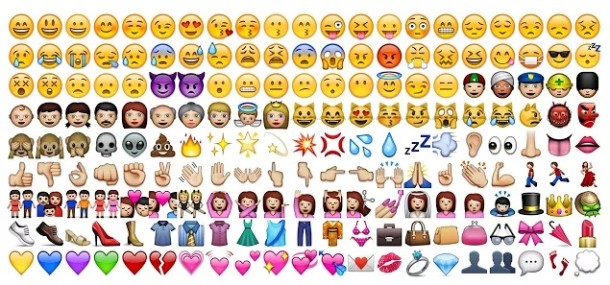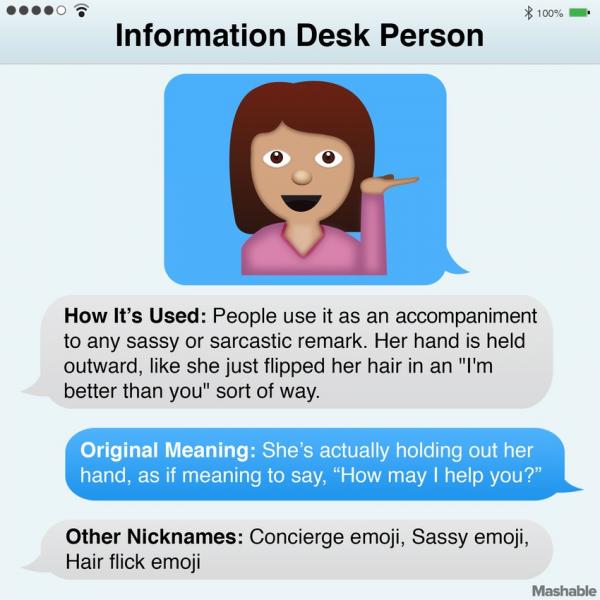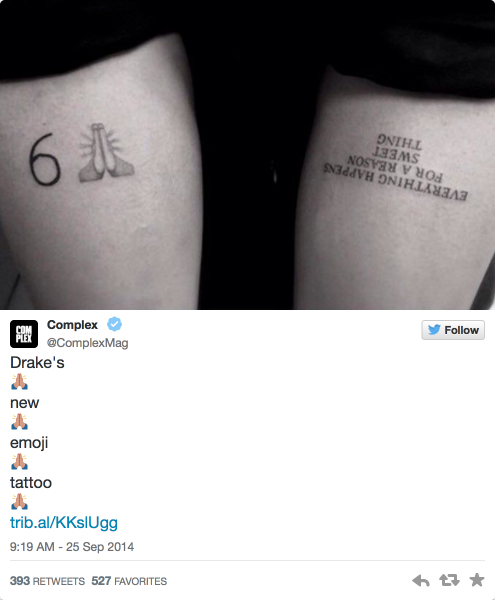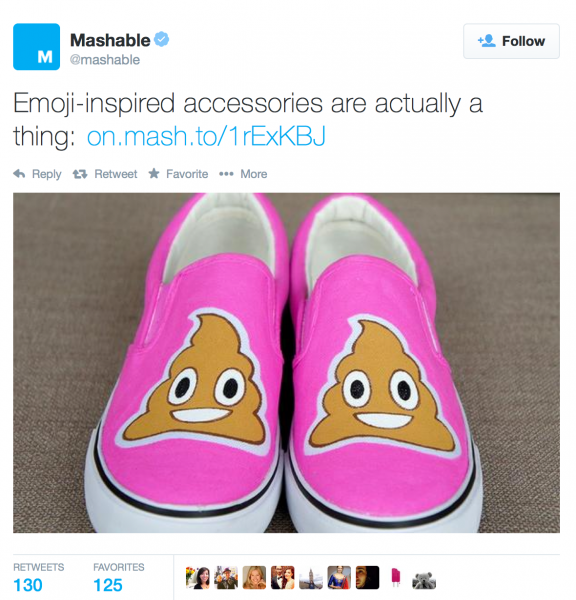Say What? How Emoji Are Changing The Way We Communicate
With the breakneck speed at which technology is advancing in the 21st century, it was only a matter of time before a whole new means of communication emerged. The latest installment is a nearly universally-understood language which has become synonymous with social media, youth, and the way in which these things have irreversibly changed modern communication:

Emoji: they're adorable, irreverent (at times widely understood and at other times cryptically specific) icons that have cropped up everywhere from Twitter to text messages. Since their rise, emoji have truly taken on a life of their own. Emoji have become so prevalent, you can now wear your beloved heart on your sleeve (or your ears or your feet) with emoji apparel and accessories.
This is all well and relevant, except that image-based languages are nothing new. They date all the way back, of course, to hieroglyphics in Ancient Egypt around 3000 BCE. And in more recent years, emojis, or rather, in their very early form, emoticons, became increasingly visible with the skyrocketing popularity of online chatrooms, instant messengers, and text messaging.
The origins of emoji as we know them today lie in Japanese webpages and text messages, and the first emoji was created sometime between 1998 and 1999 by Shigetaka Kurita. Emoji literally means “picture + character” in Japanese, which explains why many emoji are very specific to Japanese culture - a bowing businessman, a face wearing a mask, ramen and sushi, etc.
After being incorporated into Unicode, which sets the computing industry standard for encoding, in 2010, emoji were co-opted into Apple and Windows devices, as well as Google’s Gmail and other online platforms. There is also a wide range of third-party applications which allow the use of emoji on Apple, Google and Windows devices.
For a quick primer on emoji (in case you've been living under a rock), check out this pretty darn adorable mini-documentary, entitled "Emoji Among Us":
These days, it seems that emoji are popping up everywhere you turn, from clothing and throw pillows to marketing campaigns. Millennials and other social-media connoisseurs could hardly contain their excitement when it was announced in July that more than 250 new emojis would be introduced into the lexicon.
The emoji language has become so comprehensive that in 2013, after two years of work, an entirely emoji version of Moby Dick, aptly titled Emoji Dick, was published. The book contains 10,000 emoji sentences, took 800 people to create, was funded with $3,500 by 83 Kickstarter donors. The innovative collaboration of visuals can be yours for a mere $40 for the black-and-white version, or $200 for the color version.
Still, despite the ever-expanding options for emoji lovers, there are a few perennial favorites, each with its own backstory and widely understood usage. In fact, the website Emoji Tracker can show you in real time exactly which of these emoji gets the most love on Twitter:
- Information Desk Person: Supposedly meant to be a helpful woman at an information desk, this emoji has become a default for social-media savvy young women (and men!) to intone sarcasm, sass or a virtual 'whatever!'
 The "Information Desk Person" emoji (Via @Mashable/Neon Tommy)
The "Information Desk Person" emoji (Via @Mashable/Neon Tommy)
- Prayer hands (which, urban legend has it are actually two people high-fiving): An established, favored stand in for affirmations such as "praise" and "blessed," the prayer hands (or high-fiving, whichever you prefer) emoji has become inconic in its own right. In fact, rapper Drake set social media ablaze just last week when he tweeted a photo of what appeared to be the praying hands emoji tattooed on his arm. Drake has yet to confirm whether the tattoo is permanent, but regardless, it would be difficult to find ink more distinctly '2014' than this.
 Drake's alleged "emoji tattoo" (via @ComplexMag/Neon Tommy)
Drake's alleged "emoji tattoo" (via @ComplexMag/Neon Tommy)
- Poop emoji: There's really no delicate way to describe this one. This emoji is literally a pile of excrement, albeit an inexeplicably cheerful one. And yet, it's become a tried-and-true emoji favorite, a light-hearted way to tease or mock someone via text message or social media, and has even popped up on apparel and accessories, so you can finally declare your love for this lovable little emoji wherever you go.
 (via @mashable/Neon Tommy)
(via @mashable/Neon Tommy)
- Crying emoji: Easily one of the most widely-used emoji as well as one of the earliest to gain popularity, the crying-from-laughter emoji has somehow become one of the most succint and nuanced responses to anything that is deemed too funny, bizarre or just downright inexplicable to address with mere words.
 The crying-from-laughter emoji (redbubble.com/Neon Tommy)
The crying-from-laughter emoji (redbubble.com/Neon Tommy)
By now, emoji have become inescapable, so efficiently communicating in just a single icon what so many words (or no words at all) could convey. Given the fast pace of modern life, many of us use technology to keep in touch with, or even form, friendships and relationships. Emoji and other non-text-based forms of communication often assist us in doing so.
Ever since Apple integrated emoji into its iOS operating system, emoji have become a sort of demarcation of relationship statuses within one's contact list; typically, the more emojis used, the closer the relationship. And if your name is accompanied by a heart or kisses emoji, well, you should be honored.
In fact, one couple put the power of emoji to the test this past summer by communicating using only emoji in their texts. The pair, Alex Goldmark and Liza Stark, said, though it could be confusing at times, their strictly emoji-based communications also allowed for a bit more humor and playfullness. They admitted the interaction forced Alex, who described himself as a non-visual thinker, to say things in a more creative way.
Emoji are also a favorite among people who may not be as comfortable expressing their thoughts or feelings in words. This likely explains emoji popularity among younger generations for whom Facebook, Twitter, Tinder and other services have shifted a significant portion of communications online.
In fact, scroll through any Facebook or Twitter feed, and the extensive presence of emoji in captions and comments is very telling of the future of communication among younger users of technology, who are increasingly less reliant upon traditional, text-based means of conveying thoughts.
Though emoji are undoubtedly beloved by an overwhelmingly young set of technology users, not everyone is so on board with the rapid phasing out of text-based languages in the digital age.
Since virtually the beginning of texting and IMing, there have been those who have decried internet slang, abbreviations, acronyms, etc. as the end of the English language. Admittedly, to some extent, if someone was exposed to improper or informal spellings for an extended period of time, he or she may begin to incoroporate such language into every day usage. However, it seems highly unlikely that emoji or even slang will mark the demise of language as we know it.
Instead, emoji pose an even more interesting possibility; a future in which language has not become obsolete, but rather in which emojis have evolved into a truly global language. As the world becomes more divided along diversity lines, and yet simultaneously more interconnected by technology, the prospect that someday soon we may all be able to transcend our differences and speak through smiley faces is something worth a few celebratory emoji, at least in my book.
Reach Staff Reporter Olivia Niland here. Follow Olivia Niland on Twitter @olivianiland.



